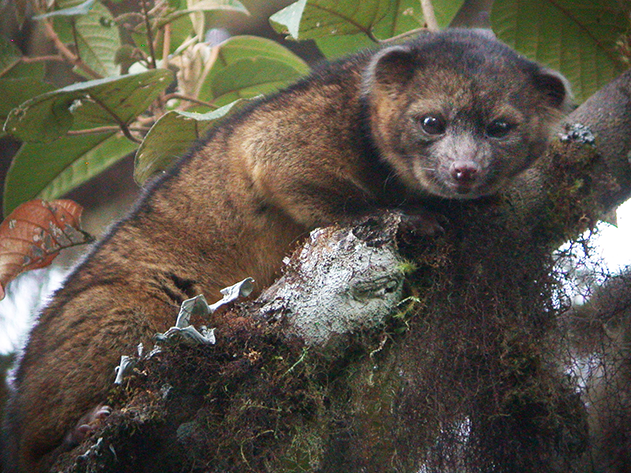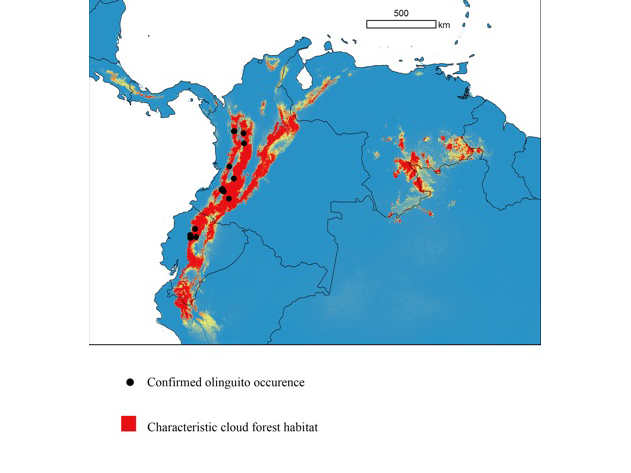It looks like you're using an Ad Blocker.
Please white-list or disable AboveTopSecret.com in your ad-blocking tool.
Thank you.
Some features of ATS will be disabled while you continue to use an ad-blocker.
12
share:
Wow this is cool!!

Smithsonian

For the really curious. Here is the peer reviewed journal entry.
ZooKeys
Abstract:
We present the first comprehensive taxonomic revision and review the biology of the olingos, the endemic Neotropical procyonid genus Bassaricyon, based on most specimens available in museums, and with data derived from anatomy, morphometrics, mitochondrial and nuclear DNA, field observations, and geographic range modeling. Species of Bassaricyon are primarily forest-living, arboreal, nocturnal, frugivorous, and solitary, and have one young at a time. We demonstrate that four olingo species can be recognized, including a Central American species (B. gabbii), lowland species with eastern, cis-Andean (B. alleni) and western, trans-Andean (B. medius) distributions, and a species endemic to cloud forests in the Andes. The oldest evolutionary divergence in the genus is between this last species, endemic to the Andes of Colombia and Ecuador, and all other species, which occur in lower elevation habitats. Surprisingly, this Andean endemic species, which we call the Olinguito, has never been previously described; it represents a new species in the order Carnivora and is the smallest living member of the family Procyonidae. We report on the biology of this new species based on information from museum specimens, niche modeling, and fieldwork in western Ecuador, and describe four Olinguito subspecies based on morphological distinctions across different regions of the Northern Andes.

Smithsonian
For all of modern history, a small, carnivorous South American mammal in the raccoon family has evaded the scientific community. Untold thousands of these red, furry creatures scampered through the trees of the Andean cloud forests, but they did so at night, hidden by dense fog. Nearly two dozen preserved samples—mostly skulls or furs— were mislabeled in museum collections across the United States. There’s even evidence that one individual lived in several American zoos during the 1960s—its keepers were mystified as to why it refused to breed with its peers.

Olinguitos, formally known as Bassaricyon neblina, inhabit the cloud forests of Ecuador and Colombia in the thousands, and the team’s analysis suggests that they are distributed widely enough to exist as four separate subspecies. “This is extremely unusual in carnivores,” Helgen said, in advance of the announcement. “I honestly think that this could be the last time in history that we will turn up this kind of situation—both a new carnivore, and one that's widespread enough to have multiple kinds.”
For the really curious. Here is the peer reviewed journal entry.
ZooKeys
Abstract:
We present the first comprehensive taxonomic revision and review the biology of the olingos, the endemic Neotropical procyonid genus Bassaricyon, based on most specimens available in museums, and with data derived from anatomy, morphometrics, mitochondrial and nuclear DNA, field observations, and geographic range modeling. Species of Bassaricyon are primarily forest-living, arboreal, nocturnal, frugivorous, and solitary, and have one young at a time. We demonstrate that four olingo species can be recognized, including a Central American species (B. gabbii), lowland species with eastern, cis-Andean (B. alleni) and western, trans-Andean (B. medius) distributions, and a species endemic to cloud forests in the Andes. The oldest evolutionary divergence in the genus is between this last species, endemic to the Andes of Colombia and Ecuador, and all other species, which occur in lower elevation habitats. Surprisingly, this Andean endemic species, which we call the Olinguito, has never been previously described; it represents a new species in the order Carnivora and is the smallest living member of the family Procyonidae. We report on the biology of this new species based on information from museum specimens, niche modeling, and fieldwork in western Ecuador, and describe four Olinguito subspecies based on morphological distinctions across different regions of the Northern Andes.
edit on 15-8-2013 by ATSmediaPRO because: (no reason given)
Cute little bugger!
I guess this means that I can still hold out hope on them finding Bigfoot(s)
I guess this means that I can still hold out hope on them finding Bigfoot(s)
Originally posted by ATSmediaPRO
A New Carnivorous Mammal Species is Discovered
So if I understand this correctly, it has not been discovered but was in fact known all along.
And that it is only know that it has been placed in a subspecies category of its own, rather than lumped in with other olingos.
As the title of the paper says "Taxonomic revision of the olingos..."
reply to post by tvtexan
Yeah its pretty cute.
To bad it would probably try and rip your face off if you tried to cuddle with it
Yeah its pretty cute.
To bad it would probably try and rip your face off if you tried to cuddle with it
edit on 15-8-2013 by xxThexGreatxEscapexx because: (no reason given)
Originally posted by TFCJay
One step closer to that elusive Bigfoot.
If we have bigfoot in a zoo wondering why it won't mate with other animals then yes. Otherwise, no.
The article so contradicts the title though?Link
So if it eats fruit does that not make it a omnivore? Or am I missing something here?: Is being an omnivore to be considered a carnivore by biologists? Still it is a cool confirmation of newish critter.
They learned that the olinguito is mostly active at night, is mainly a fruit eater, rarely comes out of the trees and has one baby at a time.
Originally posted by LionOfGOD
AWESOME!!!
Is it edible?
even though it likely is, eating carnivorous animals is not that tasty
Originally posted by hangedman13
The article so contradicts the title though?Link
So if it eats fruit does that not make it a omnivore? Or am I missing something here?: Is being an omnivore to be considered a carnivore by biologists? Still it is a cool confirmation of newish critter.
They learned that the olinguito is mostly active at night, is mainly a fruit eater, rarely comes out of the trees and has one baby at a time.
It only eats monsanto fruits. Since they contain animal dna it makes them carnivorus
new topics
-
UK and Europe Floods
Rant: 8 minutes ago -
FEMA kicks hurricane survivors out of temporary housing into snowstorm and freezing temperatures
Disaster Conspiracies: 32 minutes ago -
Failures of leadership on display
US Political Madness: 43 minutes ago -
Power grid faults surged right before Los Angeles wildfires began
Mainstream News: 44 minutes ago -
Tustin California Military equipment stolen BIG equipment .
Social Issues and Civil Unrest: 1 hours ago -
PALES-TINE, PALES-ADES and the Australian Aboriginal "Lightning Man"
Dreams & Predictions: 1 hours ago
top topics
-
Tustin California Military equipment stolen BIG equipment .
Social Issues and Civil Unrest: 1 hours ago, 8 flags -
Just Came Across These Unusual Old UFO Pics
Aliens and UFOs: 17 hours ago, 7 flags -
How To Spot Fake U.F.O. Photos
Aliens and UFOs: 13 hours ago, 6 flags -
Scary video of face in an abandoned house
Paranormal Studies: 15 hours ago, 5 flags -
Failures of leadership on display
US Political Madness: 43 minutes ago, 5 flags -
FEMA kicks hurricane survivors out of temporary housing into snowstorm and freezing temperatures
Disaster Conspiracies: 32 minutes ago, 5 flags -
Power grid faults surged right before Los Angeles wildfires began
Mainstream News: 44 minutes ago, 4 flags -
PALES-TINE, PALES-ADES and the Australian Aboriginal "Lightning Man"
Dreams & Predictions: 1 hours ago, 3 flags -
UK and Europe Floods
Rant: 8 minutes ago, 1 flags
active topics
-
This should be plastered all over the airwaves
Mainstream News • 57 • : Xtrozero -
Trump says ownership of Greenland 'is an absolute necessity'
Other Current Events • 193 • : bastion -
Los Angeles brush fires latest: 2 blazes threaten structures, prompt evacuations
Mainstream News • 401 • : xuenchen -
Tustin California Military equipment stolen BIG equipment .
Social Issues and Civil Unrest • 4 • : Phoenix -
FEMA kicks hurricane survivors out of temporary housing into snowstorm and freezing temperatures
Disaster Conspiracies • 5 • : xuenchen -
UK and Europe Floods
Rant • 0 • : crayzeed -
How To Spot Fake U.F.O. Photos
Aliens and UFOs • 7 • : Solvedit -
Failures of leadership on display
US Political Madness • 4 • : xuenchen -
PALES-TINE, PALES-ADES and the Australian Aboriginal "Lightning Man"
Dreams & Predictions • 3 • : Compendium -
Judge rules president-elect Donald Trump must be sentenced in 'hush money' trial
US Political Madness • 125 • : Vermilion
12
